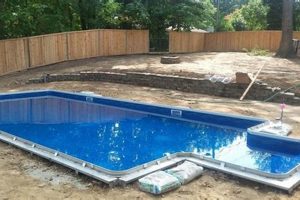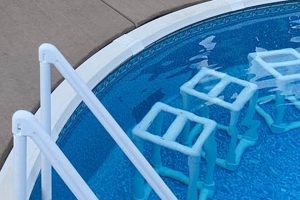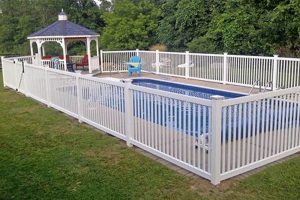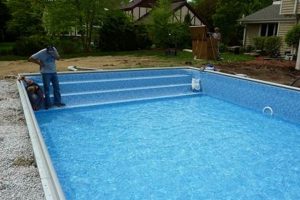A system designed to increase the temperature of water in a self-contained, elevated swimming pool, often constructed using readily available materials and basic tools. Such a system offers an alternative to commercially manufactured pool heaters, potentially reducing initial costs through self-assembly and resourcefulness. For example, a network of black hoses exposed to sunlight, connected to the pool’s filtration system, can serve as a simple, cost-effective means of solar water heating.
The rationale behind employing such a system stems from the desire to extend the swimming season, providing comfortable water temperatures during cooler periods. The benefits include reduced reliance on fossil fuels (in the case of solar-based designs), lower operational expenses compared to conventional heaters, and the satisfaction of creating a functional system. Historically, resourceful individuals have sought ways to independently manage their environment and reduce costs, leading to a variety of do-it-yourself solutions for home improvements, including alternative pool heating methods.
The subsequent sections will explore various designs, materials, safety considerations, and performance expectations associated with creating these systems. A careful evaluation of these aspects is essential for maximizing efficiency and ensuring the longevity and safe operation of a homemade pool heating solution.
Tips for Efficient and Safe Pool Water Warming
The following recommendations provide guidance for constructing and operating a system to elevate water temperature in a contained, elevated swimming pool. Prioritizing safety and efficiency is crucial for a successful outcome.
Tip 1: Material Selection. Choose durable, non-toxic materials suitable for outdoor use and prolonged exposure to water and sunlight. Black polyethylene or PVC piping, for instance, absorbs solar radiation effectively and is resistant to degradation.
Tip 2: Proper Plumbing Connections. Ensure all connections are watertight to prevent leaks and maintain optimal water pressure throughout the heating system. Use appropriate fittings and sealant designed for the chosen piping material.
Tip 3: Maximize Solar Exposure. Position the heating array in a location that receives direct sunlight for the majority of the day. South-facing orientation (in the northern hemisphere) is generally optimal.
Tip 4: Incorporate Filtration. Connect the heating system to the existing pool filtration system to remove debris and prevent clogging within the pipes. Regular filter maintenance is essential.
Tip 5: Gradual Water Circulation. Implement a slow, consistent flow rate to allow sufficient time for the water to absorb heat as it passes through the system. A small pump can regulate the flow effectively.
Tip 6: Temperature Monitoring. Install a thermometer in both the pool and the heating system to monitor performance and make adjustments as needed. This provides data for optimizing the system’s efficiency.
Tip 7: Winterization. Before freezing temperatures arrive, drain the entire heating system to prevent damage from ice expansion. Disconnect and store components if necessary.
Adherence to these suggestions will contribute to a more effective and safer pool heating experience. Careful planning and execution are paramount for achieving the desired results.
The subsequent section will present a comprehensive safety checklist to ensure that all necessary precautions have been taken to protect users and the surrounding environment.
1. Solar Heat Absorption
Solar heat absorption is a fundamental principle underpinning the effectiveness of many self-constructed pool warming systems. Efficient capture and transfer of solar energy directly correlates to the rate at which the pool water temperature increases, dictating the overall performance and viability of such a system.
- Material Emissivity and Absorption Coefficient
The selection of materials with high solar absorption coefficients and low thermal emissivity is critical. Dark-colored materials, such as black polyethylene or polypropylene, absorb a greater percentage of incident solar radiation compared to lighter-colored alternatives. Low emissivity minimizes radiative heat loss back to the atmosphere, further enhancing the overall efficiency. For example, using black PVC piping for solar collectors, as opposed to white PVC, can significantly increase the amount of heat transferred to the water circulating through the system.
- Surface Area Optimization
Maximizing the surface area exposed to direct sunlight is another crucial design consideration. A larger surface area allows for a greater quantity of solar radiation to be intercepted. Designs incorporating coiled or serpentine arrangements of tubing effectively increase the surface area within a compact footprint. Flat panel collectors, constructed with a large, dark-colored absorbing surface, similarly leverage this principle.
- Orientation and Tilt Angle
The orientation and tilt angle of the solar absorbing surface significantly affect the amount of solar radiation received throughout the day and year. Ideally, the collector surface should be oriented towards the equator (south-facing in the northern hemisphere) and tilted at an angle that optimizes solar energy capture based on the geographic latitude. An incorrect angle or orientation reduces the amount of direct sunlight intercepted, leading to diminished heating performance.
- Fluid Dynamics and Heat Transfer
The efficiency of solar heat absorption is also influenced by the fluid dynamics within the solar collector. Turbulent flow promotes better mixing and heat transfer between the heated surface and the water. A properly sized pump and tubing diameter ensures adequate flow rate and prevents stagnation, which can lead to localized overheating and reduced overall system performance. Ineffective fluid dynamics can create thermal stratification, hindering efficient heat transfer to the pool water.
The interplay of material properties, surface area, orientation, and fluid dynamics directly determines the success of a solar-based pool heating initiative. Optimizing these factors within the constraints of available resources and physical space is essential for achieving significant temperature gains in the pool water, thereby extending the swimming season and enhancing the usability of the pool.
2. Pump Circulation Rate
The pump circulation rate is a critical parameter directly impacting the efficiency and effectiveness of any self-assembled pool warming apparatus. An inappropriately sized pump will negatively affect heat transfer and overall system performance, leading to either insufficient heating or potential damage to components.
- Optimal Flow Velocity
Maintaining an optimal flow velocity through the heating system is essential for efficient heat transfer. Insufficient flow rates result in prolonged water exposure to the heating element (e.g., solar collector), leading to overheating and potential material degradation. Conversely, excessively high flow rates reduce the contact time between the water and the heat source, diminishing the amount of heat absorbed. A balanced flow rate maximizes heat absorption while minimizing the risk of material damage. For example, a flow rate that is too low may cause localized boiling within a solar collector on a sunny day.
- Head Loss Considerations
The pump must be capable of overcoming the head loss (resistance to flow) created by the piping, fittings, and heating element within the system. Head loss increases with pipe length, number of bends, and the presence of restrictive components. A pump that is undersized will be unable to deliver the required flow rate, resulting in reduced heating performance. Conversely, an oversized pump consumes more energy than necessary. Accurate calculation or estimation of head loss is necessary to select a pump with appropriate capacity.
- Pump Duty Cycle and Longevity
The pump’s duty cycle (the percentage of time it operates) affects its longevity. Continuous operation at maximum capacity can shorten the pump’s lifespan. Selecting a pump with sufficient capacity to operate at a reduced speed or for shorter durations can extend its service life. Timer-controlled operation, coordinating with daylight hours and pool usage patterns, further optimizes pump usage and energy consumption.
- Compatibility with Filtration System
The pump selected for the heating system should be compatible with the existing pool filtration system. Ensuring that the pump’s flow rate aligns with the filter’s capacity prevents damage to the filter and maintains adequate water clarity. Incompatible flow rates can lead to inefficient filtration and increased maintenance requirements.
The selection of an appropriately sized pump, considering factors such as flow velocity, head loss, duty cycle, and filtration system compatibility, is paramount for achieving optimal performance and longevity in a self-constructed pool heating system. Careful consideration of these parameters ensures efficient heat transfer, prevents material damage, and maximizes energy efficiency, ultimately enhancing the usability and enjoyment of the pool.
3. Material Temperature Resistance
Material temperature resistance is a critical factor in the design and construction of any self-assembled pool warming apparatus. The ability of materials to withstand elevated temperatures without degradation or failure directly impacts system performance, longevity, and safety. Selection of appropriate materials is therefore paramount for a successful and reliable system.
- Piping and Tubing Integrity
Piping and tubing used to transport water through the heating system must withstand both the operating temperature and potential stagnation temperatures. Stagnation occurs when water flow ceases while the heating element (e.g., solar collector) remains exposed to sunlight, leading to rapid temperature increases. Materials such as PVC may soften or deform at elevated temperatures, leading to leaks or system failure. Chlorinated Polyvinyl Chloride (CPVC) or Polypropylene (PP) offer higher temperature resistance and are more suitable for applications where stagnation is likely. Selecting piping with appropriate temperature ratings is crucial for preventing premature failure and ensuring safe operation.
- Collector Housing Durability
The enclosure surrounding the heating element, particularly in solar collectors, is subjected to prolonged exposure to both solar radiation and elevated temperatures. Materials used for the housing must resist degradation from UV exposure and thermal stress. Polycarbonate, acrylic, or specially treated polymers are often used for collector covers due to their transparency and resistance to weathering. Metal enclosures, such as aluminum, offer excellent heat dissipation and structural integrity, but may require protective coatings to prevent corrosion.
- Sealant and Adhesive Stability
Sealants and adhesives used to create watertight connections within the heating system must maintain their integrity at operating temperatures. Many common sealants can become brittle or lose adhesion when exposed to elevated temperatures, leading to leaks. High-temperature silicone sealants or specialized epoxy adhesives are often necessary to ensure reliable connections in critical areas. Proper surface preparation and application techniques are also crucial for achieving a durable and leak-proof seal.
- Pump and Component Protection
While the pump itself typically operates at ambient temperatures, it is often integrated into the heating system and can be subjected to radiated heat from nearby components. Protecting the pump from excessive heat exposure can extend its lifespan. This may involve providing adequate ventilation around the pump or using heat shielding materials to deflect radiant heat. Additionally, selecting pump components (e.g., seals, impellers) with appropriate temperature ratings is essential for reliable operation.
The long-term performance and safety of a self-assembled pool heating system are directly linked to the material temperature resistance of its constituent components. Careful selection of materials that can withstand the operating conditions and potential stagnation temperatures is crucial for preventing failures, ensuring efficient heat transfer, and maximizing the lifespan of the system. Failure to consider material temperature resistance can lead to costly repairs, reduced performance, and potential safety hazards.
4. Connection Watertight Integrity
The maintenance of watertight connections is paramount in the construction and operation of any self-assembled pool warming device. Failure to ensure complete sealing within the system results in water loss, reduced efficiency, and potential structural damage, directly impacting the overall functionality and economic viability of the heating apparatus.
- Threaded Joint Sealing
Threaded joints within the system, particularly at pump connections and pipe fittings, require meticulous sealing. The use of polytetrafluoroethylene (PTFE) tape or pipe joint compound is essential to fill microscopic imperfections in the threads, preventing water seepage. Insufficient application or use of inappropriate sealant materials compromises the integrity of the connection, leading to gradual or sudden leaks. A single compromised threaded joint can significantly diminish water pressure and overall heating efficiency.
- Solvent Welding Procedures
In systems utilizing PVC or CPVC piping, solvent welding provides a permanent, watertight bond. However, proper application of the solvent cement is critical. This includes appropriate surface preparation (cleaning and priming), even distribution of the cement, and firm insertion of the pipe into the fitting. Insufficient application, incorrect cure times, or misaligned joints result in weak, leak-prone connections. Improper solvent welding presents a significant failure point within the system.
- Hose Clamp Securement
Where flexible hosing is used to connect components, secure hose clamp installation is vital. Clamps must be properly sized for the hose diameter and tightened sufficiently to create a secure seal without damaging the hose. Overtightening can lead to hose compression and eventual failure, while undertightening fails to provide a watertight barrier. Regular inspection and retightening of hose clamps are necessary to maintain connection integrity over time, especially as materials expand and contract with temperature changes.
- Gasket and O-Ring Maintenance
Pumps and other system components often rely on gaskets or O-rings to create watertight seals. These seals can degrade over time due to chemical exposure, temperature fluctuations, and mechanical stress. Regular inspection and replacement of worn or damaged gaskets and O-rings are essential for preventing leaks. The use of appropriate lubricants can extend the lifespan of these seals and ensure a tight, reliable connection.
The integration of these sealing methods directly impacts the performance and dependability of an above ground pool warming solution. Diligent application, regular maintenance, and proactive leak detection are crucial for maximizing efficiency, preventing water loss, and ensuring the long-term operational integrity of the system. Failure to prioritize connection watertight integrity can lead to significant water waste, reduced heating capacity, and potentially costly repairs, undermining the economic benefits of a self-assembled heating apparatus.
5. Pool Water Filtration
The integration of pool water filtration with a self-constructed pool heating system is not merely advisable; it is an indispensable component for maintaining water quality, optimizing heating efficiency, and ensuring the longevity of the system. Filtration acts as a primary defense against the accumulation of debris, organic matter, and particulate contaminants within the pool water, which can directly impede the heating process and compromise the integrity of the heating apparatus. For instance, the presence of algae or mineral scale within the solar collector tubes of a DIY heating system reduces the system’s ability to absorb and transfer heat, necessitating more energy to achieve the desired water temperature. This directly correlates to increased operational costs and a decreased lifespan for the pump and other system components due to increased strain.
Furthermore, the filtration system prevents the buildup of debris within the heating apparatus itself. Sediment accumulation within the pipes and connectors of a solar heating panel, for example, can restrict water flow, leading to uneven heating and potentially causing localized overheating and material degradation. Regular filtration, through mechanical filters or diatomaceous earth systems, removes these particles, preventing them from settling and hindering heat transfer. The absence of effective filtration can lead to a cycle of reduced efficiency, increased maintenance requirements, and eventual system failure, negating the cost-saving benefits initially sought with a DIY approach. Proper filtration, therefore, ensures that the heating system operates at its designed capacity, providing consistent and efficient water temperature regulation.
In conclusion, pool water filtration is intrinsically linked to the functionality and durability of a self-made pool heating solution. Neglecting this crucial aspect undermines the system’s efficiency, accelerates component wear, and increases the risk of water quality issues. The synergy between filtration and heating creates a sustainable and cost-effective approach to pool maintenance, highlighting the importance of considering the entire ecosystem of pool care when implementing a DIY heating system. By prioritizing filtration, users can realize the full potential of their self-constructed heating apparatus and enjoy a consistently clean and comfortable swimming environment.
6. System Structural Stability
The structural integrity of a self-constructed pool heating system is not merely a secondary consideration but a fundamental prerequisite for its safe and effective operation. These systems often involve elevated components, substantial water volumes, and dynamic thermal stresses, making robust structural design paramount. A failure in structural stability can result in component collapse, water leakage, and potential injury or property damage. For example, a solar collector array mounted on a poorly constructed frame can buckle under wind load, creating a hazard and rendering the heating system inoperable. The weight of water-filled piping, especially when elevated, places significant stress on supporting structures, demanding careful calculations and appropriate material selection.
Effective structural design encompasses several key elements. Load calculations, considering the weight of water, the mass of the system components, and anticipated environmental loads (wind, snow, ice), are essential. Material selection must prioritize strength and durability, considering resistance to corrosion and degradation from UV exposure. Appropriate construction techniques, such as secure fastening methods and reinforced joints, are vital for ensuring long-term stability. For instance, supporting elevated solar collectors requires a frame constructed from treated lumber or metal, designed to withstand the combined weight of the collector, water, and potential wind forces. Diagonal bracing and secure anchoring to the ground or pool structure are crucial for preventing overturning or collapse. Moreover, thermal expansion and contraction of materials must be considered to prevent stress fractures or loosening of connections.
In summary, the structural soundness of a self-assembled pool warming solution directly correlates with its safety, performance, and longevity. Diligent planning, careful material selection, and adherence to sound construction principles are necessary to mitigate the risks associated with structural failure. Prioritizing structural stability ensures that the heating system operates reliably and safely, providing the intended benefits without compromising the well-being of users or the integrity of the surrounding environment. Neglecting this crucial aspect can transform a cost-saving measure into a liability, underscoring the importance of professional guidance and rigorous execution in the design and construction process.
Frequently Asked Questions
This section addresses common inquiries regarding the design, construction, and operation of self-assembled pool heating systems for above ground pools. The information presented aims to provide clarity and guidance based on established principles and best practices.
Question 1: What is the typical temperature increase achievable with a system?
The temperature increase varies considerably based on factors such as the system’s design, surface area of the collector, ambient temperature, solar radiation levels, and pool size. A well-designed system may raise the water temperature by 5-15 degrees Fahrenheit, although specific results are dependent on prevailing environmental conditions.
Question 2: Are permits required for such an installation?
Permitting requirements vary significantly by locality. It is the responsibility of the installer to verify local building codes and regulations to determine if permits are required for the construction or connection of the heating system. Failing to obtain necessary permits may result in fines or mandatory removal of the system.
Question 3: What safety precautions are essential?
Electrical safety is paramount. All electrical connections must comply with local codes and be performed by a qualified electrician. Proper grounding and the use of ground fault circuit interrupters (GFCIs) are mandatory. The system must be structurally sound to prevent collapse or water leakage, and materials must be compatible with pool chemicals and temperatures to prevent corrosion or degradation.
Question 4: How does the lifespan of these systems compare to commercially available heaters?
The lifespan is largely dependent on the quality of materials used and the adherence to proper construction techniques. A well-maintained system constructed with durable materials can provide several years of service. However, commercially manufactured heaters often incorporate advanced materials and design features that may extend their operational lifespan beyond that of a typical self-assembled system.
Question 5: What maintenance is required?
Regular maintenance includes inspecting connections for leaks, cleaning the collector surface to maximize solar absorption, monitoring water chemistry to prevent scaling or corrosion, and winterizing the system to prevent damage from freezing temperatures. Neglecting maintenance can reduce efficiency and shorten the lifespan of the system.
Question 6: Is it possible to automate the operation of the system?
Automation is possible through the use of timers, temperature sensors, and automatic valves. These devices can control the pump operation, diverting water to the heating system only when conditions are favorable. Automation enhances convenience and can optimize energy efficiency, but requires careful planning and installation.
These FAQs provide a foundational understanding of self-assembled pool heating systems. Further research and consultation with qualified professionals are recommended for specific applications.
The following section will explore troubleshooting common issues encountered with DIY pool heating systems, offering practical solutions and preventative measures.
Above Ground DIY Pool Heater
This exploration has underscored the multifaceted nature of constructing a self-assembled pool warming apparatus. Key areas of focus included solar heat absorption optimization, pump circulation rate management, material temperature resistance, connection watertight integrity, pool water filtration necessity, and system structural stability. Each element plays a critical role in the overall effectiveness, safety, and longevity of the implemented system.
The decision to pursue an above ground DIY pool heater solution necessitates a comprehensive understanding of these factors. While cost savings and resourcefulness are appealing, a thorough risk assessment and commitment to proper construction techniques are paramount. The long-term viability and safety of the system hinge on diligent planning and execution. Individuals should critically evaluate their capabilities and resources before embarking on such a project. A cautious and informed approach will yield the most favorable outcome.







